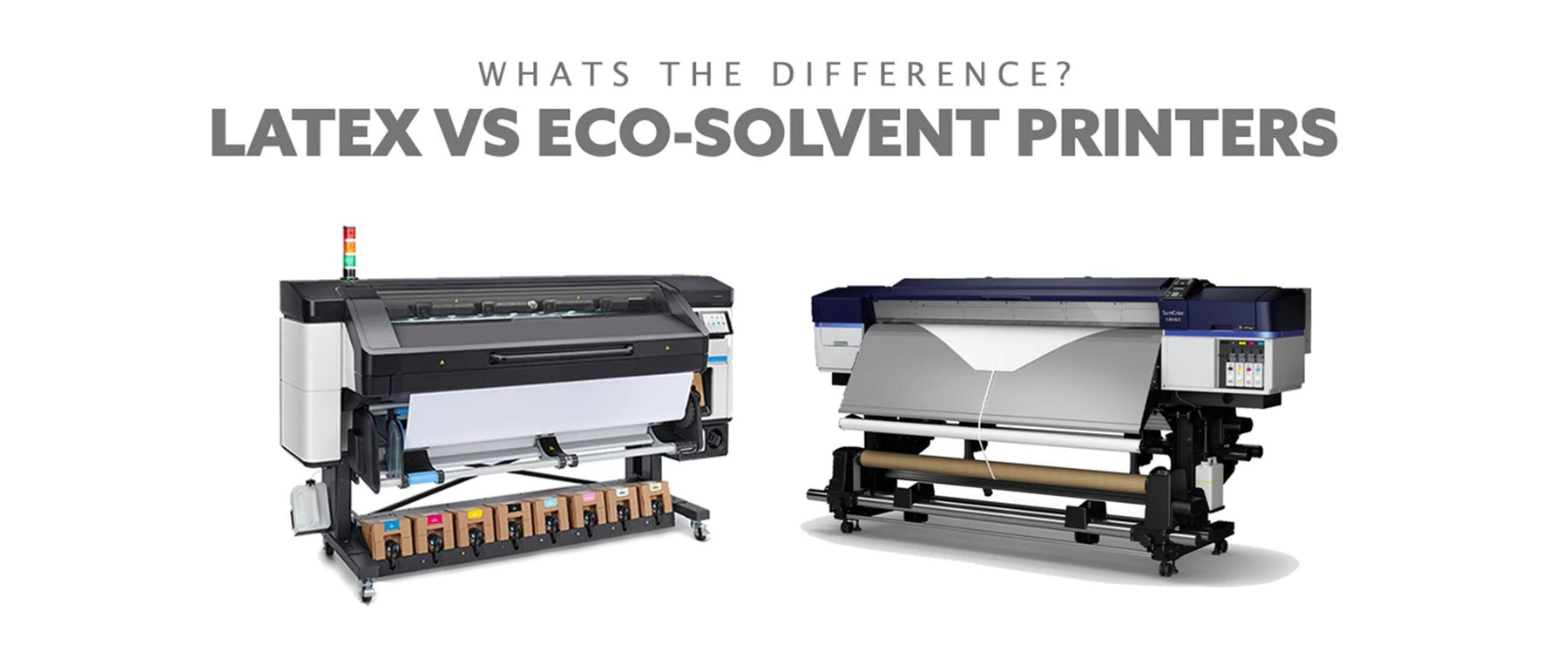
Orders 45$ & Up,
2-3 Days*
Orders 45$ & Up,
2-3 Business Days

Eco-Solvent and Latex Printing are popular printing technologies used primarily for high-quality, durable, large-format prints. Both methods are known for being more environmentally friendly compared to traditional solvent printing. Here's a closer look at each:
1. Eco-Solvent Printing
- How It Works: Eco-solvent printing uses mild, eco-friendly solvent-based inks. These inks are dissolved in an eco-friendly solvent that enables the ink to bond well to the vinyl or other materials.
- Best For: Outdoor and indoor signage, vehicle wraps, wall decals, banners, and other durable applications.
- Advantages:
- Low Odor: Unlike traditional solvent inks, eco-solvent inks produce minimal odor, making them suitable for indoor use.
- Durability: Resistant to fading, moisture, and UV exposure, so eco-solvent prints can last for years, even outdoors.
-Environmental Benefits Contains fewer volatile organic compounds (VOCs) than traditional solvents, reducing harmful emissions and making it safer for workers and the environment.
- Disadvantages: Drying time can be slightly longer than with traditional solvent inks. However, many eco-solvent printers have heaters to speed up this process.
2. Latex Printing
- How It Works: Latex printing uses water-based latex inks, which are heat-cured immediately after printing. The ink is made up of pigment particles suspended in a water-based solution with latex, a type of polymer that provides flexibility and durability.
- Best For: Indoor and outdoor applications like banners, vehicle wraps, wall graphics, textiles, and canvas.
- Advantages:
- Quick Drying: The curing process in latex printers uses heat to dry the ink almost instantly, so prints are ready for use or finishing immediately.
- High Image Quality: Produces vibrant colors and sharp images, making it great for high-resolution prints.
Environmental Benefits Water-based, VOC-free, and safe for indoor use in places like hospitals, schools, and restaurants.
- Disadvantages: Latex printers can be more expensive, and prints might require specialized media that can handle the heat-curing process.
Comparison of Eco-Solvent and Latex Printing
Both methods deliver durable, vibrant, and eco-friendly prints, with latex offering a faster drying time and suitability for a wider range of indoor applications. Eco-solvent printing, however, is typically more affordable for businesses looking for outdoor-grade quality.
Typically ships out in 24 hours 2-3 days shipping time (free shipping) Product Details Premium 4mm Collapsible Slim Can Koozies Holds Most Slim...
View full detailsTypically ships out in 24 hours 2-3 days shipping time (free shipping) Description: Enjoy a cold beer, a spiked seltzer, or your favorite Beer D...
View full detailsTypically ships out in 24 hours 2-3 days shipping time (free shipping) Product Details FREE SHIPPING on this item over $45 Premium 4mm Collapsi...
View full detailsTypically ships out in 24 hours 2-3 days shipping time (free shipping) Product Details FREE SHIPPING on this item over $45 Premium 4mm Colla...
View full detailsTypically ships out in 24 hours 2-3 days shipping time (free shipping) Product Details Premium 4mm Collapsible Slim Can Koozies Holds Most Sl...
View full detailsEnjoy a cold beer, a spiked seltzer, or your favorite Beer Drink flavor while keeping it cold, crisp, and delicious with a QualityPerfection can co...
View full detailsTypically ships out in 24 hours 2-3 days shipping time (free shipping) Product Details Premium 4mm Collapsible Slim Can Koozies Holds Most Slim...
View full detailsSamples - Might be with colors defects or print, We choose them randomly. Neoprene and foam are not the same shades of colors. The price is for 100...
View full detailsTypically ships out in 24 hours 2-3 days shipping time (free shipping) Product Details Premium 4mm Collapsible Slim Can Koozies Holds Most S...
View full details3 Magnets Slim can cooler sleeves FREE SHIPPING on this item over $45 Premium 4mm Collapsible Slim Can Coolers Holds Most Slim 12 oz. Cans Col...
View full details
Leave a comment